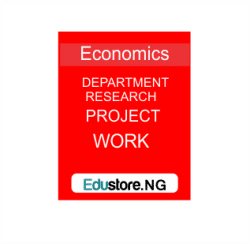TRADE OPENNESS AND OUTPUT GROWTH IN NIGERIA: AN ECONOMETRIC ANALYSIS (1970-2007)
TRADE OPENNESS AND OUTPUT GROWTH IN NIGERIA: AN ECONOMETRIC ANALYSIS (1970-2007)
ABSTRACT
This research work studies the international competitiveness of the Nigerian economy in the global market by analyzing the relationship between trade openness and output growth in Nigeria. Using time-series data over the period 1970-2007, we show that output growth of the Nigeria economy is a function of two sets of shocks; (i) external shocks (openness and real exchange rate) and (ii) internal shocks (real interest rate and unemployment rate). A non-monotonic and an ANCOVA econometric models are postulated in order to capture the structural pattern of the relationship between openness and output growth as well as the policy effect of structural Adjustment program (SAP). The result shows that there is an inverted U-shape (no-monotonic) relationship between openness and output growth in Nigeria and the optimum degree of openness for the economy is estimated to be about 67%. Also, the liberalization policy of the SAP has positive economic effect on the output growth. The ECM reveals that 79% of the equilibrium error is being corrected in the next period. We concluded that unbridled openness may have deleterious effect on the real growth of output of the Nigerian economy.
TABLE OF CONTENTS
CHAPTER ONE: INTRODUCTION
1.1 Background of study
1.2 Trade openness and output growth
Historical Experience of the Nigeria economy
1.2 Statement of the research problem
1.3 Objectives of the study
1.4 Statement of the research hypothesis
1.5 Justification of the study
1.6 Significance of the study
1.7 Scope and limitation of the study
CHAPTER TWO: LITERATURE REVIEW
2.1 Theoretical literature
2.1.2 Theory of customs union and free trade areas 2.1.3Models of export-led growth
2.2 Empirical literature
2.3 Limitation of previous studies
CHAPTER THREE: METHODOLOGY
3.1 Analytical framework
3.2 Model specification
3.2.1 Test of stationarity
3.2.2 Test of co integration
3.2.3 Error correction model
3.3 Justification of the model
3.4 Estimation techniques
3.5 Evaluation Procedure 3.5.1 Economic test (a priori expectation)
3.5.2 Statistical (first order) test
3.5.3 Econometric (second order) test
3.6 Sources of data and software for estimation
CHAPTER FOUR: PRESENTATION AND ANALYSIS OF RESULTS
4.1 Introduction
4.2 Presentations of regression results
4.2.1Test of stationarity
4.2.2 Test of co integration
4.2.3 The Error correction model (ECM)
4.3 Interpretation and Evaluation of result
4.3.1Evaluation based on economic criteria
4.3.2Evaluation based on statistical criteria
4.3.3 Evaluation based on econometric criteria
4.4 Evaluation of the working Hypotheses
CHAPTER FIVE: SUMMARY, POLICY PRESCRIPTION
AND CONCLUSION
5.1 Summary
5.2 Policy Recommendations
LIST OF TABLES AND FIGURES
Figure 1: Growth Rate of Real GDP
Figure 2: Trend of Real GDP
Figure 3: Growth of Export and Import
Figure 4: The Degree of Openness
Table 1: Openness Indicators
Table 2: A Priori Expectation
Table 3: Results of Model 1
Table 4: Results of Model 2
Table 5: Results of Stationarity test
Table 6: Results of Co integration test
Table 7: Results of the Error Correction Model
Figure 5: Non- Monotonic Relationship between TPN and RGDP
Table 8: Summary of the T-Test
Table 9: Pair-Wise Correlation Matrix
CHAPTER ONE
INTROUDCTION
1.1 BACKGROUND OF STUDY
DOWNLOAD COMPLETE WORK- For Reference Only: Materials are for research, citation, and idea generation purposes and not for submission as your original final year project work.
- Avoid Plagiarism: Do not copy or submit this content as your own project. Doing so may result in academic consequences.
- Use as a Framework: This complete project research material should guide the development of your own final year project work.
- Academic Access: This platform is designed to reduce the stress of visiting school libraries by providing easy access to research materials.
- Institutional Support: Tertiary institutions encourage the review of previous academic works such as journals and theses.
- Open Education: The site is maintained through paid subscriptions to continue offering open access educational resources.



